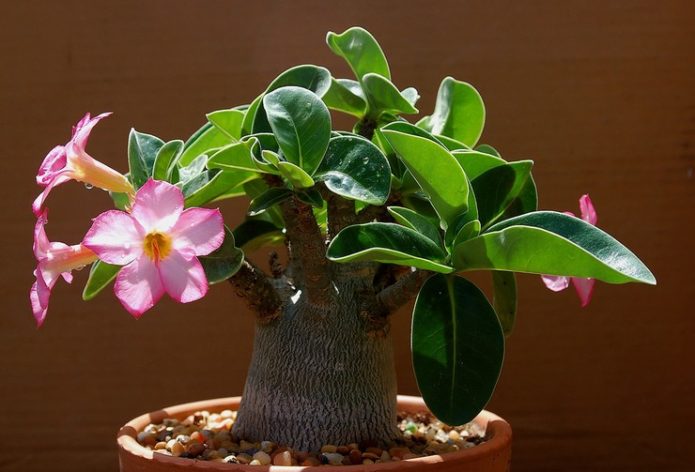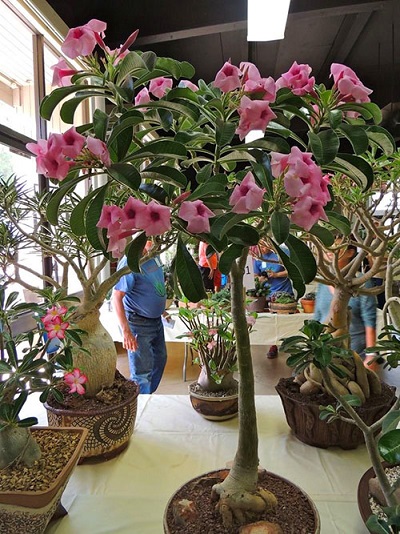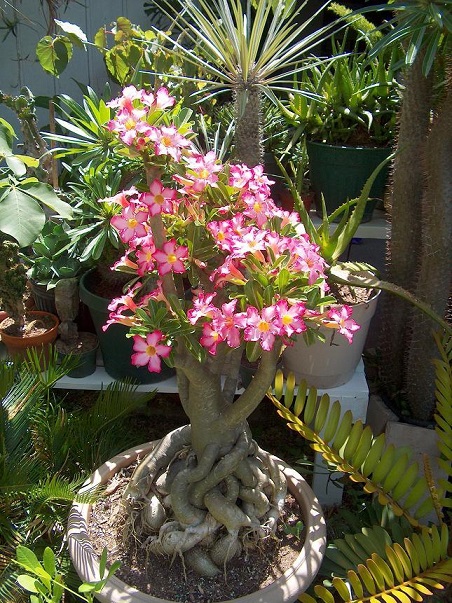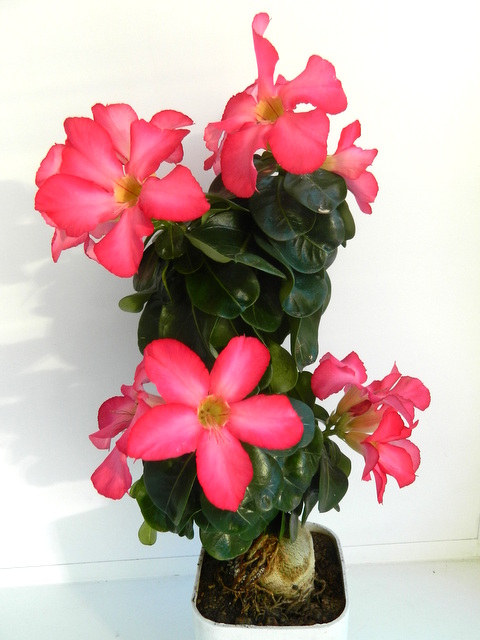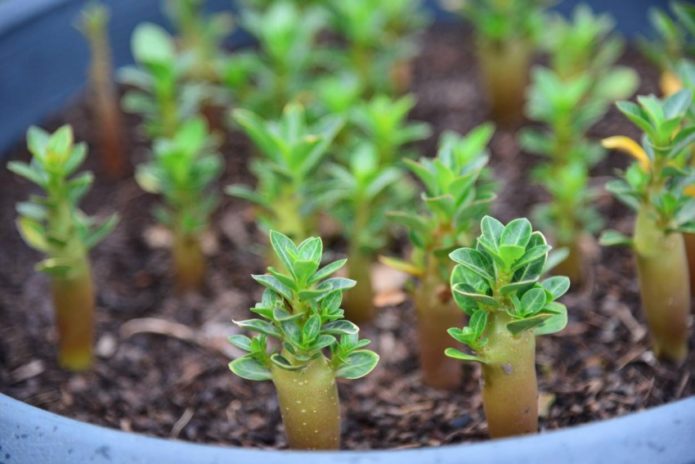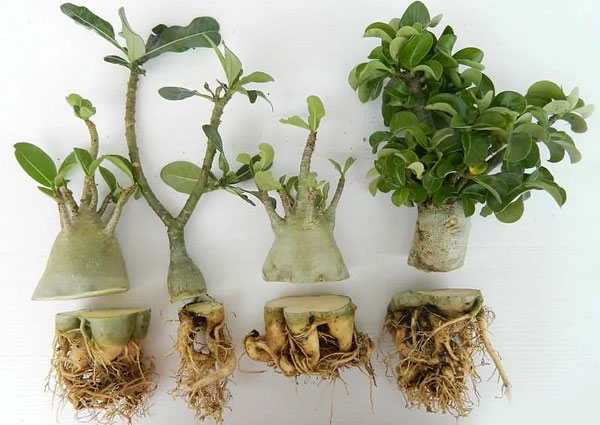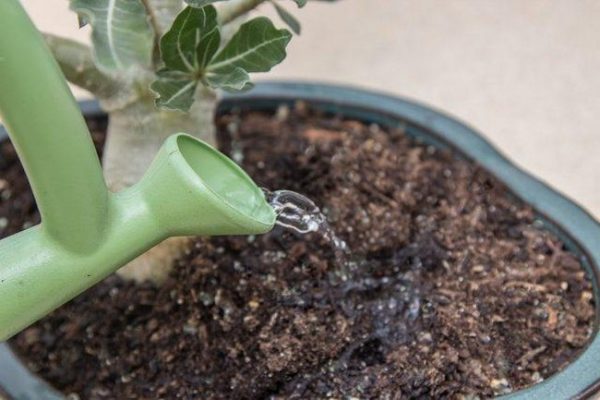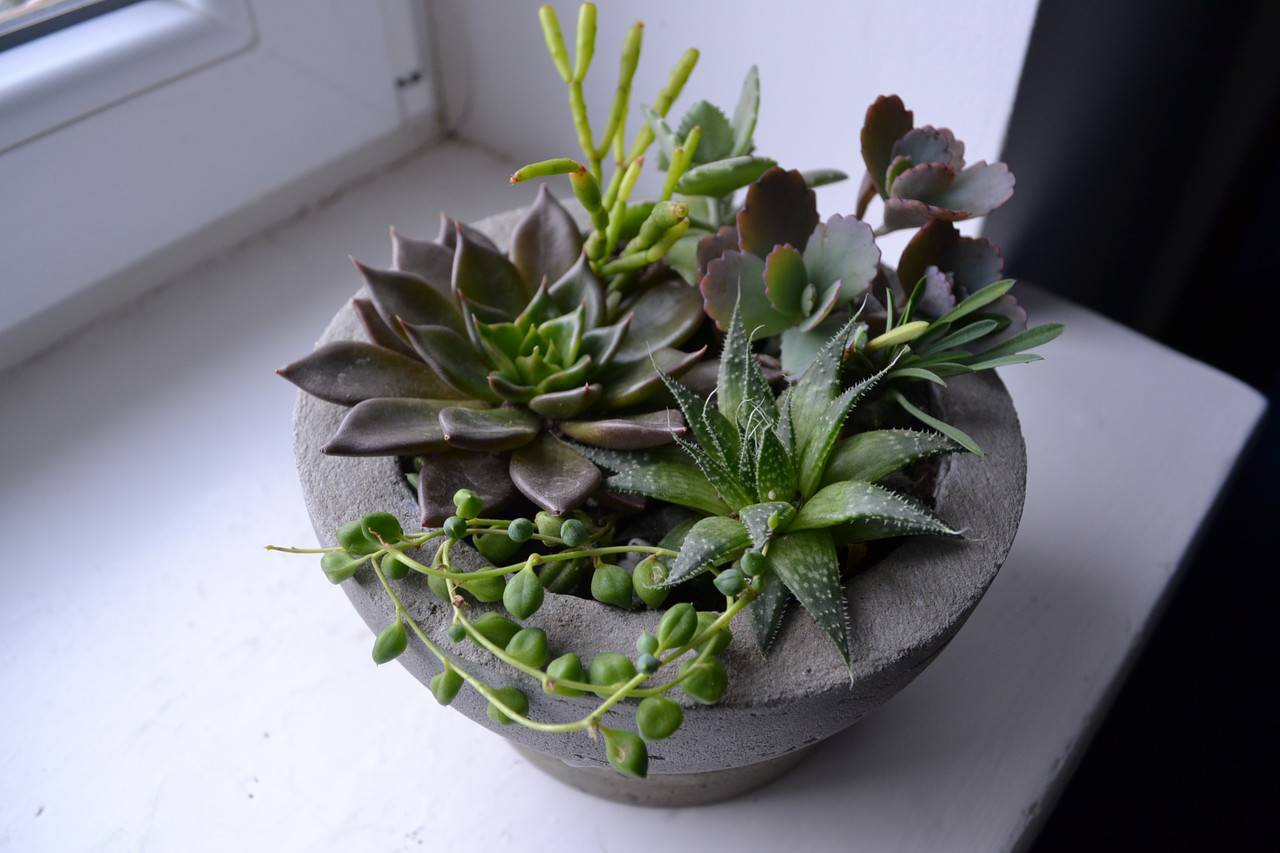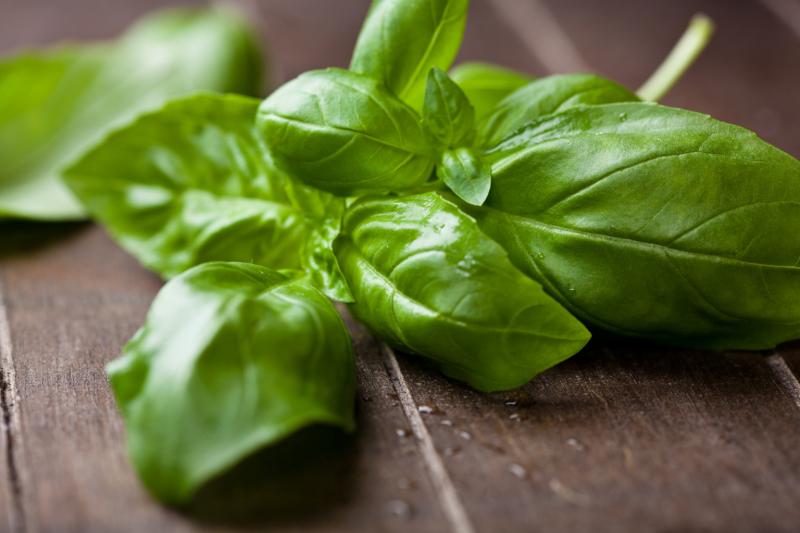Adenium is a tropical succulent with a developed tree-like stem, which in its natural habitat reaches a height of 3 meters. As a house plant, adenium began to be grown at the end of the last century, and interest in this wonderful tree only increases every year. Thanks to the work of breeders, the indoor version of adenium is compact in size. There are about 50 varieties of this succulent, which differ in the shape of the leaves, the color of the flowers. Exotic lovers willingly purchase an attractive plant for their home collection.
Content
Features of growing exotic adenium
For home cultivation, multiple varieties of a hybrid called Adenium obese are used. Its trunk is thickened and looks like a bottle, so the succulent is often called the bottle tree. The flowers of the plant, depending on the hybrid species, have a different color and shape.
Despite its beauty, the plant can be dangerous - its juice is poisonous. When working with adenium, skin and eye protection products are used. If there are small children and animals in the house, then the flower should be kept out of their reach.
Adenium experiences two periods during the year, when the simultaneous phase of growth and vegetation is replaced by a stage of rest. Indoor specimens retain this developmental feature. The dormant period begins in the last decade of October and lasts until early March. At this time, the succulent sheds foliage, which will reappear in the spring. As the leaves grow, flower buds are formed in the desert rose. Flowers have a lifespan of 7 to 10 days.
Adenium varieties with photos and descriptions
In botany, ten types of adenium are distinguished, and all other classification forms are their varieties and subspecies. Common indoor varieties are as follows.
Arab
The variety is divided into two subspecies: Yemeni and Saudi. The diameter of the skeletal branches of the Yemeni subspecies is larger than that of the Saudi. In winter, the Yemeni subspecies sheds all the foliage, while the Saudi subspecies hibernates with leaves. The Arabic variety is characterized by a strong hairiness of the trunk with foliage.
The flowering of this variety is most often pink flowers, but sometimes species with white buds are found.
Boehmianum
The plant differs from its counterparts in that it grows leaves up to 15 cm in size. The growing and flowering period is short - throughout the year this variety pleases the eye with flowers and leaves for only 3 months.
The color of the flowers is pink, and closer to the core, their shade is replaced by a rich cherry color.
Multi-flowered
The roots and trunk of this variety are highly developed, the plant has a decorative appearance due to their visual massiveness. Flowering in young specimens begins only at 4–5 years of age. During the dormant period, the succulent drops all the foliage.
The flowering of the multiflorous variety is abundant, the flower diameter is 5–7 cm, the leaves grow up to 12–15 cm.
Somali
The trunk is highly developed, the leaves are oblong, 5–10 cm in size, fall off in winter. The flowering of young plants begins in a year and a half from the moment of planting, when the adenium grows by about 15–20 cm.
Flowers are traditionally pink, but there are other colors as well. The abundance of sunlight affects the duration of flowering.
Fat
Widespread variety for home cultivation. The massive trunk branches well, and during the growing season the adenium is covered with flowers. After winter dormancy, buds appear on it earlier than leaves.
In winter, the plant sheds its foliage. It blooms profusely, the color of the flower is monochrome or variegated.
Mini
The plant differs from its counterparts in miniature size. The hybrid variety grows no more than 17–20 cm and blooms in the second year of life. In the presence of bright sunlight, the hybrid can bloom all year round.
In a miniature tree, flowers reach a size of 5-7 cm. Their color is pink, red, white or pink-white.
The varietal variety of adenium is amazing. The choice of plants for home collection is able to satisfy the most demanding preferences.
Planting and growing methods
In order for the adenium to have a thickened trunk, it is necessary to grow the plant from seeds, since it will be difficult to achieve this during grafting. Desert rose seeds quickly lose their germination, so when buying planting material, pay attention to the expiration date. Fresh seeds have 99% germination and there are no problems with their germination.
Florist experts believe that the end of February - the beginning of March is suitable for germinating seeds. For 3 spring months, the plant has time to take root and get stronger, entering the growing season. It is not necessary to soak the seeds before sowing. In a horizontal position, they are buried 0.5 cm into the moistened soil of a mini-greenhouse. Strong waterlogging of the soil should not be allowed, the greenhouse is opened daily for 15–20 minutes. for airing. Seeds germinate in 4-7 days, but sometimes this process can be delayed for 2 or 3 weeks.
After 2-3 months, when young specimens have several leaves, they are planted in a permanent place for further growth. Adenium will bloom after planting no earlier than 1.5-2 years.
When a plant is propagated by cuttings, planting material can be purchased ready-made or obtained from an adult plant. Rooted cuttings flower much earlier than seed-grown specimens. Growing by cuttings allows you to preserve the plant's breeding properties without mutations. If you cut off the lower root part from the adenium, then the top and roots will be viable and can grow on their own.
Sections of cuttings need to be dried and powdered with charcoal powder, as they quickly rot. In a container for planting near the cutting, clean river sand mixed with crushed charcoal is placed. Root survival occurs in 3-4 weeks at a temperature of + 25 °. At this time, the soil is sprayed from a sprayer as it dries up.
Young adeniums are actively starting to grow and they need an annual transplant into a more spacious container.Saplings from seeds are transplanted 1 time per quarter, increasing the volume of the planting capacity, and their counterparts, who have grown by cuttings, need a transplant only after a year. The pot should be chosen wide, since the root system of the adenium is powerful. If during transplanting each time a part of the root system is raised above the soil level, then over time it turns into a kind of ornate trunk.
To create favorable growth conditions, a drainage layer is placed on the bottom of the pot, and the soil is selected light, airy and hygroscopic. The reaction of the soil is allowed from neutral to slightly acidic. To obtain such characteristics, crushed vermiculite or perlite is added to the soil.
Adenium care at home
In indoor conditions, a bottle tree grows up to 50-60 cm, and even a novice florist can take care of it. Since an exotic plant is warm and light-requiring, the agricultural technology of its cultivation has some peculiarities.
Adenium is one of those plants that grows in the open rays of the sun and does not require shading, so it is placed in the house on the windows facing the south. If the bottle tree does not have enough lighting, it will go into dormancy mode and during this time its growth will stop. Adenium should receive sunlight for at least 12 hours per day. In the case when the flower has been in the shade for some time, it should not be sharply exposed to the sun - the foliage will receive serious burns. It is necessary to accustom the plant to bright light gradually, for 1 hour a day, increasing the time spent in the sun.
The succulent tolerates heat easily, the range from +23 to + 30 ° C and above is considered a comfortable temperature for it. If the thermometer drops to + 10 ° C, the roots of the flower will begin to freeze and the plant may die within 3-4 weeks.
Adenium does not need spraying and normally tolerates dry air. The humidity level is permissible up to 70%; at higher rates, the roots of the flower will begin to rot.
How to care during growth and flowering: watering, fertilizing, pruning
For irrigation, settled warm water is used; it is necessary to irrigate an earthen lump only when it dries up. Do not forget that the inhabitants of the desert easily tolerate drought and do not like excessive soil moisture. Watering is performed in the morning or evening, when the sun's rays are not so active that the plant gets burned during the procedure.
Adenium needs feeding from the beginning of awakening after winter rest. Fertilizers are applied in spring and summer. For these purposes, you can use ready-made complex formulations designed for succulents. If you want to make the formula yourself, you need to take equal parts of phosphorus, potassium and nitrogen. You can feed the plant 2 times a month, and from the moment the flower buds appear, the frequency of fertilizing is increased. At the beginning of August, fertilization is stopped, as the flower begins to gradually prepare for winter rest.
To stimulate branching of the crown and create a decorative look, adenium is regularly pinched and pruned. These procedures should be carried out in compliance with the rules:
- pruning and pinching is done only during the growing season;
- 2-3 days before the procedure, the plant is not watered so that its branches are elastic;
- trimming is performed with a knife or pruning shears to obtain an even cut;
- the cut line should be 2–3 mm above the level of the dormant kidney;
- before each cut, the blade of a knife or pruner is wiped with alcohol;
- the protruding juice is blotted with a napkin;
- pinching and cutting are done not lower than the first pair of leaves, not counting the cotyledonous leaves.
Any cut from a plant is afraid of water, since the tissues of the bottle tree are prone to decay.Sections are first dried in the open air, and then covered with garden mastic or powdered with charcoal powder.
Caring for the plant after flowering
In autumn, when the air becomes cool and the length of daylight hours decreases, the plant's development process slows down. Withered flowers are removed, feeding at this time is no longer carried out, and watering is reduced. Over the summer period, the roots of adenium filled the entire pot and waterlogging of the soil in combination with cold air can cause them to rot.
For wintering, a desert rose is transferred to a glazed balcony or to any other room where there are no cold drafts, and the air temperature will be from +12 to + 15 ° C. During the dormant period, adenium does not require attention to itself; irrigating the soil at this time is possible only if it is very dry. In this mode, the succulent lives until spring. At the moment of awakening of the buds, the flower pot is transferred to its original place.
Diseases and problems of flower care
If you follow the measures to protect the cuts when pruning the plant and prevent decay of the trunk and roots, observing the temperature regime and the frequency of watering, then other diseases of adenium are not terrible. But there is another danger - an invasion of insect pests.
When you notice that adenium flowers wither, leaves fall off, a grayish-white bloom appears on the soil, thin stripes cover the trunk of the plant, or a spider web appears on the leaves and shoots - this means that your green pet needs urgent help.
Succulents are often affected by the mealybug, which likes to live in dry warm soil and damages the root system of the plant by feeding on its juice. It is not easy to notice this pest in a timely manner, it reveals itself even when the plant is seriously damaged.
Adenium can also be attacked by other pests: aphids, thrips or spider mites. Small green aphids choose the inner side of young leaves and feed on their juices. Outwardly, the leaves look eaten, with small holes or spots.
Thrips are small insects with wings that have a piercing-sucking apparatus with which they drink juices from the leaves of the plant. It is not difficult to spot thrips - you will notice a flock of midges above the flower.
The spider mite is also a dangerous plant-based pest. It can be detected by the presence on the shoots and leaves of a dense white-gray web with small insects around the lesion.
You can save a plant only if you treat it with an insecticidal preparation in time: Confidor, Intavir, Fitoverm or their analogues. As a preventive measure, it is recommended to treat the soil with insect pests once every six months.
Video: we grow a desert rose ourselves
A few tips from experienced florists
- In order for the plant to develop evenly, it is periodically turned in different directions relative to the light source. If this is not done in time, the desert rose can grow lopsided or with a curved crown.
- When sending a plant to a cool room for the winter, check the humidity level in it. With high humidity, the chance that the plant will be susceptible to a fungal disease is great. Cool air is safe for adenium only in dry rooms.
- Adult plants do not need frequent replanting, it is enough to do this once every 3 years. Do not wet the soil after transplanting. Wait for the ground to dry out - this will allow the roots to take root better.
Adenium attracts with its exotic uniqueness. Watching its gradual development is a fascinating experience. Desert rose is viable, it responds to care with the beauty of abundant flowering. Such an instance of a house plant will be appropriate in any interior, decorating it with its presence.
